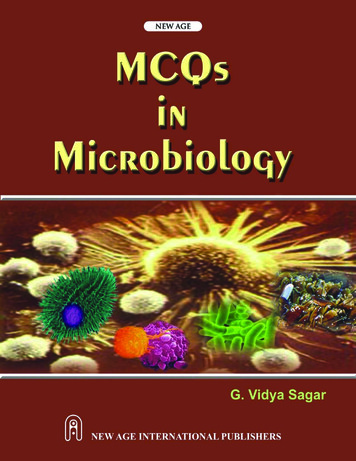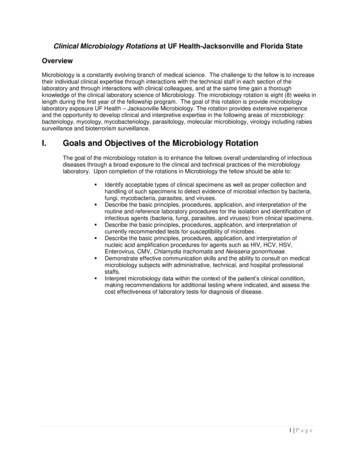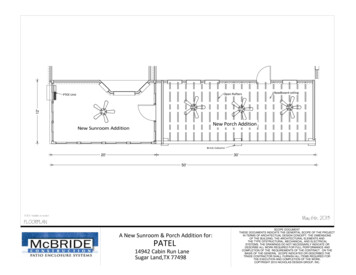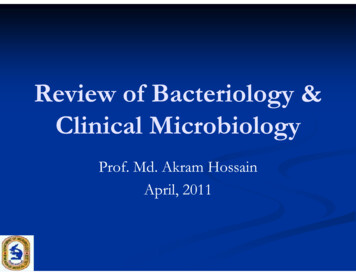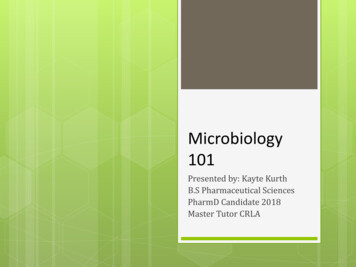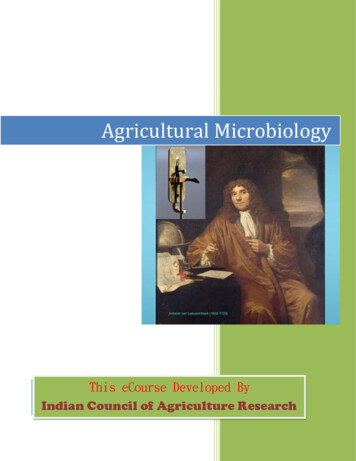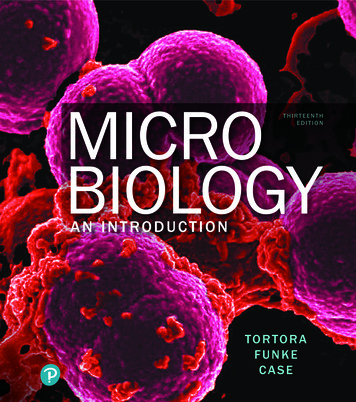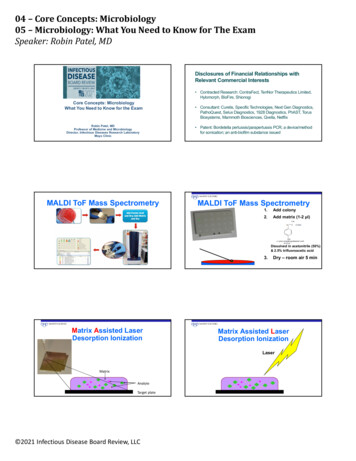
Transcription
04 – Core Concepts: Microbiology05 – Microbiology: What You Need to Know for The ExamSpeaker: Robin Patel, MDDisclosures of Financial Relationships withRelevant Commercial Interests Contracted Research: ContraFect, TenNor Therapeutics Limited,Hylomorph, BioFire, ShionogiCore Concepts: MicrobiologyWhat You Need to Know for the Exam Consultant: Curetis, Specific Technologies, Next Gen Diagnostics,PathoQuest, Selux Diagnostics, 1928 Diagnostics, PhAST, TorusBiosystems, Mammoth Biosciences, Qvella, NetflixRobin Patel, MDProfessor of Medicine and MicrobiologyDirector, Infectious Diseases Research LaboratoryMayo Clinic Patent: Bordetella pertussis/parapertussis PCR; a device/methodfor sonication; an anti-biofilm substance issuedMALDI ToF Mass SpectrometryMALDI ToF Mass Spectrometry1.Add colony2.Add matrix (1-2 μl)Dissolved in acetonitrile (50%)& 2.5% trifluoroacetic acid3.Matrix Assisted LaserDesorption IonizationDry – room air 5 minMatrix Assisted LaserDesorption IonizationLaserMatrixAnalyteTarget plate 2021 Infectious Disease Board Review, LLC
04 – Core Concepts: Microbiology05 – Microbiology: What You Need to Know for The ExamSpeaker: Robin Patel, MDMatrix Assisted LaserDesorption Ionization Time of FlightDetectorDrift region Accelerating potentialMass Spectrum GeneratedCompared with Library (Database)QUESTION #1Which of the following will not grow on sheepblood, chocolate and/or MacConkey agar?A. Granulicatella adiacensB. Bordetella pertussisC. Brucella melitensisD. Vibrio choleraeE. Abiotrophia defectivaBACTERIA REQUIRING SPECIALIZED MEDIAQUESTION #2 Bordetella pertussis Legionella species Brucella species ( /-) Mycoplasma species ( /-)Which of the following bacteria may stain acid-fastpositive? Burkholdheria pseudomallei ( /-) Ureaplasma species Campylobacter species Francisella tularensis ( /-) Helicobacter pyloriA. Rhodococcus speciesB. Cutibacterium speciesC. Finegoldia speciesD. Microbacterium speciesE. Wolbachia species 2021 Infectious Disease Board Review, LLC
04 – Core Concepts: Microbiology05 – Microbiology: What You Need to Know for The ExamSpeaker: Robin Patel, MDACID-FAST BACTERIA(MYCOLIC ACIDS)QUESTION #3 Mycobacterium species “Modified” acid fast stain positive Weaker decolorizing agent (0.5-1% sulfuric acid in place of 3% acidalcohol); do not stain well with Ziehl-Neelsen or Kinyoun staino Nocardia specieso Rhodococcus specieso Gordonia specieso Tsukamurella specieso Dietzia speciesA laboratory technologist who has a longstandinghistory of diabetes mellitus inadvertently opens thelid of an agar plate growing an organism which issubsequently determined to be Burkholdheriapseudomallei.You are asked to make a recommendation regardingpostexposure prophylaxis. Tatlockia (Legionella) micdadei and some Corynebacterium species [But not Cutibacterium (or Propionibacterium) species]QUESTION #3Burkholderia pseudomallei Laboratory ExposureWhich of the following would you recommend?Low risk Inadvertent opening of the lid of an agar plate growing B. pseudomallei outside a biologic safety cabinetEventsInadvertent sniffing of agar plate growing B. pseudomallei in the absence of contact between worker and bacteriumSplash event leading to visible contact of B. pseudomallei with gloved hand or protected body, in the absence of any evidence ofaerosolA. Trimethoprim-sulfamethoxazoleB. AmoxicillinC. StreptomycinD. CephalexinE. NoneSpillage of small volume of liquid culture ( 1mL) within a functioning biologic safety cabinetContamination of intact skin with cultureHigh risk The presence of any predisposing condition without proper personal protective equipment (PPE): diabetes mellitus; chronic liver orEvents kidney disease; alcohol abuse; long-term steroid use; hematologic malignancy; neutropenia or neutrophil dysfunction; chronic lungdisease (including cystic fibrosis); thalassemia; any other form of immunosuppressionNeedlestick or other penetrating injury with implement contaminated with B. pseudomalleiBite or scratch by experimental animal infected with B. pseudomalleiSplash event leading to contamination of mouth or eyesGeneration of aerosol outside biologic safety cabinet (e.g., sonication, centrifuge incident)Peacock SJ et al. Emerg Infect Dis. 2008 Jul olderia pseudomalleiPostexposure Antimicrobial Drug ProphylaxisAntimicrobial P-SMX)2 160–800 mg (960 mg) tablets if 60 kg, 3 80–400 (480 mg) tablets if 40 kg-60 kg, and 1 160–800mg (960 mg) or 2 80–400 (480 mg) tablets if adult 40 kg plus folate 5 mg/dEvery 12 h2.5 mg/kg/dose up to 100 mg orallyEvery 12 h20/5 mg/kg/dose. Equates to 3 500/125 tabs if 60kg, and 2 500/125 tabs if 60kgEvery 8 hDoxycyclineAmoxicillin–clavulanic acidQUESTION #4Which of the following, if present in a clinical specimen,poses a hazard for laboratory personnel?a. Entamoeba histolyticab. Trichuris trichiurac. Enterobius vermicularisd. Strongyloides stercoralise. Babesia microtiPeacock SJ et al. Emerg Infect Dis. 2008 Jul http://wwwnc.cdc.gov/eid/article/14/7/07-1501 2021 Infectious Disease Board Review, LLC
04 – Core Concepts: Microbiology05 – Microbiology: What You Need to Know for The ExamSpeaker: Robin Patel, MDStrongyloides stercoralis Larvae - two forms1. Rhabditiform (in stool)2. FilariformInfectious stage that develops in soil and occasionallyin patient (leads to autoinfection and is hazardous tolaboratory personnel) Larvae detected Microscopically (top) or By placing feces on plate and detectingmigrating larvae where they leave a trail ofbacterial colonies (bottom)LABORATORY- ACQUIRED BACTERIAL, FUNGALAND PARASITIC INFECTIONS (SELECTED) Bacillus anthracis Francisella tularensis Brucella species Mycobacterium tuberculosis Burkholdheria pseudomallei (Burkholdheria mallei) Neisseria meningitidis Salmonella enterica subsp. entericaserovar Typhi Coxiella burnetii Coccidioides immitis/posadasii(Blastomyces dermatitidis, Histoplasmacapsulatum) Dermatophytes Staphylococcus aureus Strongyloides stercoralis Yersinia pestis Enteric pathogensORGANISMS ABOUT WHICH THE LABORATORYSHOULD BE NOTIFIED IF SUSPECTED Avian influenza Bacillus anthracis Brucella species Burkholdheria pseudomallei Burkholdheria mallei Clostridium botulinum Coxiella burnetii Coccidioides immitis/posadasii Hemorrhagic fever viruses(e.g., Ebola, Marburg, Chapare, Crimean-Congo,Guanarito, Hanta, Junin, Kayasnur Forest Disease, Lassafever, Lujo, Machupo, Omsk Hemorrhagic Fever, Sabia) Francisella tularensis Measles MERS, SARS-CoV Nipah virus, Hendra virus Smallpox Yersinia pestisFDA-APPROVED/CLEARED MULTIPLEX PANELS FORGASTROINTESTINAL PATHOGENS IN STOOLNumber of targetsCampylobacter speciesSalmonella speciesShigella species/Enteroinvasive E. coliVibrio speciesYersinia enterocoliticaEscherichia coli 0157Enterotoxigenic E. coliEnteropathogenic E. coliEnteroaggregative E. coliPlesiomonas shigelloidesShiga toxin-producing E. coliClostridioides difficileNorovirus GI/GIIRotavirus AAstrovirusAdenovirus 40/41SapovirusCryptosporidium speciesEntamoeba histolyticaGiardia lambliaCyclospora cayetanensisVerigene EP8 Luminex GPP14 BioFire GIP22 Curetis, Specific Technologies, Next Gen Diagnostics, PathoQuest, Selux Diagnostics, 1928 Diagnostics, PhAST, Torus Biosystems, Mammoth BioscieTESTING ALGORITHM FOR ACUTE GASTROENTERITISBIOFIRE FILMARRAYMENINGITIS/ENCEPHALITIS PANELVirusesClostridioides difficile testing 2021 Infectious Disease Board Review, LLCCytomegalovirusEnterovirusHerpes simplex virus 1Herpes simplex virus 2Human herpes virus 6Human parechovirusVaricella zoster virusBacteriaFungiCryptococcus neoformans/gattiiEscherichia coli K1Haemophilus influenzaeListeria monocytogenesNeisseria meningitidisStreptococcus agalactiaeStreptococcus pneumoniae
04 – Core Concepts: Microbiology05 – Microbiology: What You Need to Know for The ExamSpeaker: Robin Patel, MDFDA-Approved Multiplex Respiratory PanelsMeningitis/Encephalitis Panel AlgorithmParameterAnalysis platformAcceptable specimensNumber of targetsPathogensVirusesAdenovirusCoronavirus (229E, HKU1, NL63, OC43)Coronavirus HKU1Coronavirus NL63Coronavirus 229ECoronavirus OC43SARS‐CoV‐2Human bocavirusHuman metapneumovirusInfluenza ASubtype H1Subtype H3Subtype 2009 H1N1Influenza BParainfluenza 1Parainfluenza 2Parainfluenza 3Parainfluenza 4Respiratory syncytial virusRespiratory syncytial virus ARespiratory syncytial virus BRhinovirus/enterovirusBacteriaChlamydophila pneumoniaeMycoplasma pneumoniaeBordetella pertussisBordetella parapertussisB. parapertussis/Bordetella bronchisepticaBordetella holmesiiThroughputTime to resultFilmArrayVerigeneNxTAG‐RPPFilmArray system orFilmArrayTorchNP swab20Verigene systemLuminex MAGPIXeSensorePlex systemNP swab16NP swab20NP swab14NP swab18 (differentiates B/E from C) eSensor RVPePlex Low 2‐3 hoursScalable1 hourHigh 4 hoursMedium 6 hoursScalable 1.5 hoursRamanan et al. Clin Microbiol Rev 2018;31:1-28Lower Respiratory Tract PanelsCuretisUnyveroBacteriaAcinetobacter spp.Acinetobacter calcoaceticus-baumannii complexChlamydia pneumoniaeCitrobacter freundiiEnterobacter aerogenesEnterobacter cloacaeEnterobacter cloacae complexEscherichia coliHaemophilus influenzaeKlebsiella oxytocaKlebsiella pneumoniaeKlebsiella pneumoniae groupKlebsiella variicolaLegionella pneumophilaMoraxella catarrhalisMorganella morganiiMycoplasma pneumoniaeProteus spp.Pseudomonas aeruginosaSerratia marcescensStaphylococcus aureusStenotrophomonas maltophiliaStreptococcus agalactaieStreptococcus pneumoniaeStreptococcus pyogenesBioFire CuretisUnyveroVirusesInfluenza AInfluenza BRespiratory Syncytial VirusHuman Rhinovirus/EnterovirusHuman MetapneumovirusParainfluenza virusAdenovirusCoronavirus (non-SARS-CoV)SARS‐CoV‐2Resistance blaOXA058-likeblaVIMblaCTX-MblaTEMmecAmecA/C and MREJBioFire QUESTION #5 QUESTION #5 You are asked to see a 62 year old man with a positiveblood culture to advise on management. Gram stain of the positive blood culture bottle shows Grampositive cocci in clusters. A rapid PCR panel performed on the positive blood culturebottle contents detects Staphylococcus aureus,Staphylococcus epidermidis as well as mecA/C but notmecA/C and MREJ.FDA-Approved Multiplex Panels for Detectionof Select Organisms and Resistance Genes in Positive Blood CulturesFilmArray BCID2Which of the following is the interpretation of this finding?A. Methicillin-susceptible S. aureus and methicillin-resistant S.epidermidisB. Methicillin-susceptible S. aureus and methicillin-susceptible S.epidermidisC. Methicillin-resistant S. aureus and methicillin-resistant S.epidermidisD. Methicillin-resistant S. aureus and methicillin-susceptible S.epidermidis 2021 Infectious Disease Board Review, LLCVERIGENE Gram-Positive Blood Culture TestGram-positive bacteriaGram-negative bacteria*Detected as Enterobacter speciesStaphylococcus speciesStaphylococcus aureusStaphylococcus epidermidisStaphylococcus lugdunensisStreptococcus speciesStreptococcus agalactiaeStreptococcus pyogenesStreptococcus pneumoniaeStreptococcus anginosus groupEnterococcus speciesEnterococcus faecalisEnterococcus faeciumListeria speciesListeria monocytogenesBacillus cereus groupBacillus subtilis groupCorynebacterium speciesCutibacterium acnesLactobacillus speciesMicrococcus speciesPan Gram-PositiveKlebsiella oxytocaKlebsiella pneumoniaeKlebsiella pneumoniae groupKlebsiella aerogenesSalmonella speciesMorganella morganiiStenotrophomonas maltophiliaSerratia speciesSerratia marcescensProteus speciesProteus mirabilisAcinetobacter speciesAcinetobacter baumanniiAcinetobacter calcoaceticus-baumannii complexHemophilus influenzaeCronobacter sakazakiiNeisseria meningitisPseudomonas aeruginosaEnterobacteralesEscherichia coliEnterobacter speciesEnterobacter cloacae complexCitrobacter speciesBacteroides fragilisFusobacterium necrophorumFusobacterium nucleatumPan Gram-Negative GenMarkDxGram-Negative Blood CultureTestePlex BCID-GP Panel * * ePlex BCID-GN Panel
04 – Core Concepts: Microbiology05 – Microbiology: What You Need to Know for The ExamSpeaker: Robin Patel, MDSTAPHYLOCOCCIFDA-Approved Multiplex Panels for Detection of Select Organismsand Resistance Genes in Positive Blood Cultures, a albicansCandida aurisCandida dubliniensisCandida famataCandida glabrataCandida guilliermondiiCandida kefyrCandida kruseiCandida lusitaniaeCandida parapsilosisCandida tropicalisCryptococcus gattiiCryptococcus neoformansC. neoformans/gattiiFusarium speciesRhodotorula speciesPan CandidamecAmecCmecA/CmecA/C and mcr-1VERIGENE Gram-Positive BloodGram-Negative BloodCulture TestCulture TestePlex BCID-GPPanel GenMarkDxePlex BCID-FPPanel Methicilllin resistance mediated by mecA (or rarely mecC) gene products Penicillin binding protein (PBP) target altered (PBP2a)o Confers resistance to all available β-lactams (except ceftaroline)o Even if staphylococci that are methicillin-resistant appear susceptible to theseother β-lactams, they are not effective T2Direct DiagnosticsDirect from Blood Multiplex PCR and T2 magnetic resonance, average turnaround time 4.3 hours T2Candida Panel Candida albicans Candida tropicalis Candida krusei Candida glabrata Candida parapsilosis T2Bacteria Panel Enterococcus faecium Staphylococcus aureus Klebsiella pneumoniae Pseudomonas aeruginosa Escherichia coliQUESTION #6How often should this test be performed?A.B.C.D.E.DailyTwice a weekWeeklyEvery two weeksMonthlyMETHICILLIN RESISTANCEePlex BCID-GNPanel Oxacillin or cefoxitin tested mecA/C and MREJ specific for Staphylococcus aureus For serious infections, susceptibility to oxacillin confirmed using PBP2atesting or nucleic acid amplification test (NAAT) to detect mecA (and mecC)QUESTION #6 A 52 year old woman receives a liver transplant (CMV D /R-)at your medical center. Seven months later (after she has completed a course ofvalganciclovir), she develops fever and diarrhea and isfound to have a CMV viral load of 20,000 IU/ml. In addition to treating the patient with intravenousganciclovir and performing a colonoscopy to assess forCMV colitis, you recommend follow-up CMV viral loadtesting.OPTIMAL FREQUENCY CMV VIRAL LOAD TESTING Weekly viral load testing sufficient to document antiviral response,antiviral resistance emergence T1/2 virus 5-8 days May rise 1st few days on therapy Obtain baseline viral load day therapy started Treatment Until viral clearance, symptom resolution and 2 week minimum Changes 3-fold ( 0.5 log) Biologically important changes in viral replication Preemptive treatment weekly viral load testing 2021 Infectious Disease Board Review, LLC
04 – Core Concepts: Microbiology05 – Microbiology: What You Need to Know for The ExamSpeaker: Robin Patel, MDQUESTION #7QUESTION #7You are consulted to advise on the course of action for a 57 year oldfemale liver transplant recipient (transplant for alcoholicsteatohepatitis; CMV D /R ) who has a whole blood HHV-6 viral loadof 3.6x106 copies/ml at three months post-transplant. The test wasperformed because of a report of subjective fever of four days’duration. She has no other new symptoms. The patient received onemonth of acyclovir prophylaxis post-transplant and is currentlyreceiving mycophenolate mofetil, prednisone and trimethoprimsulfamethoxazole. Her post-transplant course was complicated byone episode of treated rejection on day 30 post transplant. Physicalexamination is unremarkable and she is afebrile.CHROMOSOMALLY INTEGRATEDHUMAN HERPESVIRUS-6 High HHV-6 levels in whole blood ( 5.5 log10 copies/ml) Suggest chromosomally integrated HHV-6Which of the following would you recommend?A.B.C.D.E.Intravenous ganciclovirOral valganciclovirOral acyclovirIntravenous foscarnetNo antiviral therapy is indicatedQUESTION #8A 65 year old man has multiple blood cultures positive for Pseudomonasaeruginosa resistant to amikacin, gentamicin, tobramycin, aztreonam,cefepime, ceftazidime, meropenem, piperacillin-tazobactam, ciprofloxacin,and levofloxacin. You call the clinical microbiology laboratory to requestsusceptibility testing of an additional antimicrobial.Which of the following is most appropriate? 1:1 ratio of viral to human genomesPellett et al. Rev Med Virol 2012;22:144-55QUESTION #9You are asked to see a 43 year old woman toadvise on management of a positive bloodculture. Gram stain of her blood culture bottle showsGram-negative bacilli. A rapid PCR panel performed on the positiveblood culture bottle contents detectsEnterobacteriaceae and blaKPC. 2021 Infectious Disease Board Review, mD.OritavancinQUESTION #9The blaKPC gene product would be expected toconfer resistance to which of the following?A. CefepimeB. PlazomicinC. ColistinD. Ceftazidime/avibactam
04 – Core Concepts: Microbiology05 – Microbiology: What You Need to Know for The ExamSpeaker: Robin Patel, MDTYPICAL SUSCEPTIBILITY OF A KPC-PRODUCERKlebsiella pneumoniae carbapenemase producerEscherichia coliAmpicillin 16 RAmpicillin/Sulbactam 16/8 RPiperacillin/Tazobactam 64/4 RCefazolin 16 ROral cephalosporinsCefepime 16 RCeftazidime 16 RCeftriaxone 32 RErtapenem 1 RAztreonam 16 RCiprofloxacinRMeropenem 8 RLevofloxacin4IAmikacin 32 RGentamicinTobramycin4STigecycline2STMP/SMXTYPICAL SUSCEPTIBILITY OF AN ESBL-PRODUCER– Extended spectrum beta-lactamase producerAmpicillin 16 RAmpicillin/Sulbactam 16/8 RPiperacillin/Tazobactam 16/4 SCefazolin 16 ROral cephalosporinsCefepime 2 RCeftazidime 16 RCeftriaxone 32 RErtapenem 0.5 S 8 RMeropenem 1 SAztreonam 16 RCiprofloxacin 1 S 2/38 RR 16 RLevofloxacin 2 SAmikacin 8 SGentamicin 1 STobramycin4STigecycline2STMP/SMX 2/38 RQUESTION #11QUESTION #10Which of the following susceptibility patterns would be typical foran Escherichia coli isolate carrying a New Delhi metallo- lactamase d)RRRRRRCARBAPENEMASE PRODUCTION TESTCarba NP TESTWhich of the following tests for carbapenemaseproduction?A. PBP2a testB. D-testC. Carba NP testD. Polymerase chain reaction assayCARBAPENEMASE PRODUCTION TESTMODIFIED CARBAPENEM INACTIVATIONCarbapenemase-Production Negative(zone of growth inhibition) β-lactam ring hydrolyzed bycarbapenemaseM pH (detected by indicator dyecolor change red yellow)Organism 1No imipenemOrganism 1ImipenemOrganism 2No imipenemOrganism 2Imipenem Rapid (2 hours)MPlace disk on MuellerHinton agar plateinoculated with lawn ofEscherichia coli 25922Incubate 18-24 hMResuspend testorganism in TSBPositive CarbapenemaseProducerNegative CarbapenemaseNon-Producer 2021 Infectious Disease Board Review, LLCAdd meropenem diskIncubate 4h @35 CCarbapenemase-Production Positive(no zone of growth inhibition)
04 – Core Concepts: Microbiology05 – Microbiology: What You Need to Know for The ExamSpeaker: Robin Patel, MDQUESTION #12The image shows Staphylococcus aureus grown with anerythromycin disc (left) and a clindamycin disc (right).Which of the following is the correct interpretation of theseresults?A.Erythromycin susceptibility, inducible clindamycinresistanceB.Erythromycin resistance, constitutive clindamycinresistanceC.Erythromycin resistance, inducible clindamycin resistanceD.Erythromycin susceptibility, constitutive clindamycinresistanceINDUCIBLE CLINDAMYCIN RESISTANCE(D-TEST) Erythromycin & clindamycin disksincubated on plate Flattening of zone of inhibitedgrowth between disks inducibleclindamycin resistance (top)INDUCIBLE CLINDAMYCIN RESISTANCE(D-TEST) Macrolide resistance from alteration in ribosomal target co-resistance to clindamycin; constitutive or inducible Constitutive, erythromycin & clindamycin test resistant Inducible, erythromycin tests resistant but clindamycin testsfalsely susceptible (Macrolide resistance due to efflux no effect onclindamycin)QUESTION #13 You are asked to see a 95 year old woman who is aresident of a long-term care facility to advise on therapyfor bacteremia associated with a urinary tract infection. She has had two sets of blood cultures collected, both ofwhich signaled positive after 17 hours of incubation. Gram stain of the bottles is shown. If erythromycin does not influencezone around clindamycin disk,clindamycin susceptible (bottom)QUESTION #13Which of the following is the most likely identityof the blood culture isolate?A. Enterococcus gallinarumB. Enterococcus faeciumC. Enterococcus faecalisD. Enterococcus casseliflavusE. Enterococcus avium 2021 Infectious Disease Board Review, LLC A rapid PCR panel performed on the positive blood culturebottle detects Enterococcus species as well as vanA/vanB.ENTEROCOCCIVANCOMYCIN SUSCEPTIBILITY TESTING Vancomycin MICs 32 μg/mlo Typically VanA or VanB mediated resistanceo Typically E. faeciumo Epidemiologically significant Vancomycin MICs, 8-16 μg/ml (intermediate)o VanCo E. gallinarum or E. casseliflavus/flavescenso Not epidemiologically significant
04 – Core Concepts: Microbiology05 – Microbiology: What You Need to Know for The ExamSpeaker: Robin Patel, MDQUESTION #14QUESTION #14A 44 year old man who underwent bilateral lungtransplantation for pulmonary hypertension develops asternal wound infection with sternal dehiscence 15 dayspost-transplant.Blood cultures are negative. He undergoes sternaldebridement with the finding of purulence and negativeGram and KOH stains.After three days of incubation, pinpoint, clear colonies arevisualized on cultures on sheep blood agar, howeverGram stain of these colonies is negative.Mycoplasma hominis Post-cardiothoracic transplant Pleuritis, surgical site infection and/or mediastinitisWhich of the following is the most appropriateempiric antibiotic to treat this patient?a) Cefepimeb) Ceftriaxonec) Trimethoprim-sulfamethoxazoled) Azithromycine) DoxycyclineQUESTION #15A transplant hepatologist calls to inquire about ganciclovir resistance testing ona liver transplant patient with CMV colitis and the following CMV viral loads:7/01/16: 26,000 IU/ml (day of diagnosis)7/11/16: 25,000 IU/ml7/20/16: 22,000 IU/ml7/31/16: 27,000 IU/ml Treatment Inactiveo Cell wall active antibioticso Trimethoprim/sulfamethoxazoleo Aminoglycosideso Erythromycin and azithromycin The patient is CMV D /R-, received 3 months of valganciclovir prophylaxis,and now has CMV disease after discontinuing valganciclovir. He has been receiving full dose intravenous ganciclovir since July 1st and hisdiarrhea is unchanged. Activeo Tetracyclines (doxycycline preferred)o Fluoroquinoloneso ClindamycinSampath, R., et al. EBioMedicine (2017), ION #15QUESTION #16A plasma test for mutations in which of thefollowing genes is most appropriate?Results of testing show a M460V UL97 mutation. Thismutation would be expected to confer resistance to:A.B.C.D.E.A.B.C.D.E.UL51UL54UL89UL97Testing is unlikely to be helpful given the patient’s viralload 2021 Infectious Disease Board Review, LLCCidofovirFoscarnetGanciclovirGanciclovir and foscarnetGanciclovir and cidofovir
04 – Core Concepts: Microbiology05 – Microbiology: What You Need to Know for The ExamSpeaker: Robin Patel, MDCYTOMEGALOVIRUS ANTIVIRAL RESISTANCE Risk factors Prolonged drug exposure D R-, lung transplant recipient Amplify and sequence directly from plasma (viral load 1,000 IU/ml required) 6 weeks antiviral drug exposure Should include 2 weeks full-dose therapy before testing Accelerated schedule: Poor host factors, extreme viral loadsGeneDrug(s) affectedUL97GanciclovirUL54Ganciclovir and cidofovir (if selected for by these agents); foscarnet (if selected for by foscarnet)Kotton CN et al. Transplantation 2013;96:333 and Chou S. Curr Opin Infect Dis 2015:28;293 2021 Infectious Disease Board Review, LLC
2021 Infectious Disease Board Review, LLC Core Concepts: Microbiology What You Need to Know for the Exam Robin Patel, MD Professor of Medicine and Microbiology Director, Infectious Diseases Research Laboratory Mayo Clinic Disclosures of Financial Relationships with Relevant Commercia


